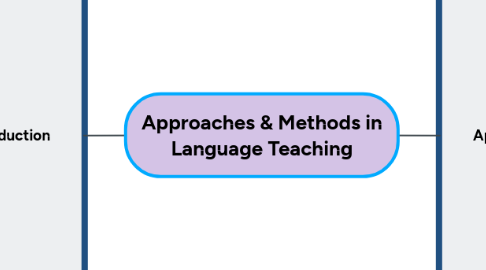
1. Approach & Method
1.1. Representatives
1.1.1. Henry Sweet (1845-1912)
1.1.2. Otto Jespersen (1860-1943)
1.1.3. Harold Palmer (1877-1949)
1.2. Quality of Language
1.2.1. Approach
1.2.1.1. nature of language
1.2.1.1.1. Theory of Language
1.2.1.1.2. Theory of Learning
1.2.2. Desing
1.2.2.1. Syllabus Model
1.2.2.1.1. Selection
1.2.2.1.2. Organization
1.2.2.2. Types of Learning
1.2.2.3. Teaching Activities
1.2.2.4. Learner Roles
1.2.2.4.1. Types of Learning
1.2.2.4.2. Content of Learning
1.2.2.4.3. Influence the Learning
1.2.2.4.4. Process
1.2.2.4.5. Performer
1.2.2.4.6. Problem Solve
1.2.2.5. Teacher Roles
1.2.2.5.1. Types of Functions
1.2.2.5.2. Influence over Learning
1.2.2.5.3. Types of Interaction
1.2.2.5.4. Form Materials
1.2.3. Procedure
1.2.3.1. Classroom Techniques
1.2.3.1.1. Practices
1.2.3.2. Resources in Items
1.2.3.2.1. Space
2. Introduction
2.1. Educational debate & innovation
2.1.1. The Emergence of Methods
2.1.1.1. Focused
2.1.1.1.1. Changes
2.1.2. The Ifluence of Latin
2.1.2.1. Second Language
2.1.2.2. Appered
2.1.2.2.1. 500 years
2.1.2.3. Dominated
2.1.2.3.1. Education
2.1.2.3.2. Commerce
2.1.2.3.3. Religion
2.1.2.3.4. Government
2.1.2.4. Representated
2.1.2.4.1. Cicero
2.1.2.4.2. Virgil
2.1.2.4.3. Ovid
2.1.3. The Grammar Translation Method
2.1.3.1. Exponents
2.1.3.1.1. Johann Seindestücker
2.1.3.1.2. Karl Plötz
2.1.3.1.3. Johann Meindinger
2.1.3.2. Characteristics
2.1.3.2.1. Learn in Order
2.1.3.2.2. Memorizing Rules
2.1.3.2.3. Reading
2.1.3.2.4. Writing
2.1.3.2.5. Grammar
2.1.3.2.6. Comparisions
2.1.4. Language Teaching Innovation
2.1.4.1. Contributed in G.T.M
2.1.4.1.1. Questioning
2.1.4.1.2. Rejection
2.1.4.2. New approaches
2.1.4.2.1. Germany
2.1.4.2.2. England
2.1.4.2.3. France
2.1.4.2.4. Parts of Europe
2.1.5. The Reform Movement
2.1.5.1. The Practical Study of Language
2.1.5.1.1. Careful selection
2.1.5.1.2. Imposing limits
2.1.5.1.3. Arranging Skills
2.1.5.1.4. Grading Materials
2.1.5.2. Reformers
2.1.5.2.1. Spoke Language
2.1.5.2.2. Findings of Phonetics
2.1.5.2.3. Grammar Rules
2.1.5.2.4. Traslation
2.1.6. The Direct Method
2.1.6.1. Characteristics
2.1.6.1.1. Clasroom Instruction
2.1.6.1.2. Vocabulary
2.1.6.1.3. Oral Comunication
2.1.6.1.4. Grammar
2.1.6.1.5. Correct Pronuntation
2.1.7. The Methods Era
2.1.7.1. Approch or Methods
2.1.7.1.1. Good Practice
2.1.7.2. Particular Approaches
2.1.7.2.1. Alternative Ways
2.1.7.3. Teacher Training
2.1.7.3.1. Teaching Methods
2.1.8. Approches and Methods in Teacher Preparations Programs
2.1.8.1. Past & Present
2.1.8.2. Introduces
2.1.8.2.1. Procedures
2.1.8.2.2. Variety of Pronciples
2.1.8.2.3. Teacher to the issues
